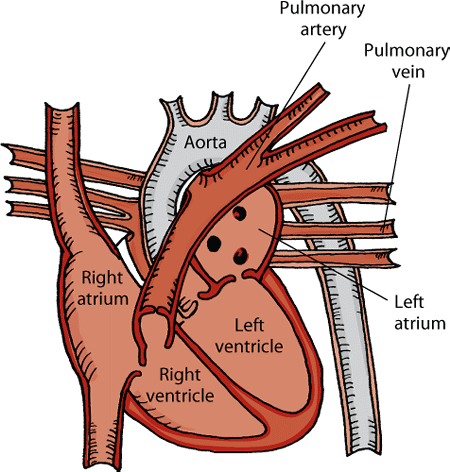Most pet parents have heard the terms pneumonia and congestive heart failure. Many have even heard of valve disease in dogs and cats. These are example of common heart and lung problems in pets. An under-appreciated cause of cardiopulmonary clinical signs in our furry companions is pulmonary hypertension. So, this week’s post is dedicated to this condition in an effort to raise awareness. I hope you find the information helpful. Happy reading!

Pulmonary Hypertension – What is it?
To understand pulmonary hypertension, one needs to have a basic understanding of heart and lung anatomy. Deoxygenated blood returns from the body to the right atrium of the heart. From there, it passes into the right ventricle where it is pumped through the pulmonary arteries to the lungs to be oxygenated. Once the blood is re-oxygenated, blood travels through the pulmonary veins to the left atrium of the heart. It then flows into the left ventricle where it is pumped through the aorta to all of the body’s organs.

Pulmonary hypertension occurs when the pressure in the pulmonary arteries (the tube that connects the right ventricle to the lungs) is elevated. Normal pressure in these blood vessels is 10-15 mmHg, and pulmonary hypertension is defined as a sustained pressure greater than 25 mmHg. There are many potential causes for increased pressure in the pulmonary arteries, and as such, pulmonary hypertension is often divided into categories:
- Group I – pulmonary arterial hypertension: classic examples of this form of pulmonary hypertension are heartworm disease and congenital heart defects between the right and left sides of the heart
- Group II – pulmonary venous hypertension: this form may develop when patient’s develop left-sided heart failure. Common causes of left-sided heart failure include dilated cardiomyopathy, hypertrophic cardiomyopathy, and chronic valvular disease.
- Group III – pulmonary hypertension associated with loss oxygen content: this type may develop secondary to primary lung disease and/or when patient’s live at high altitudes
- Group IV – pulmonary hypertension due to chronic thromboembolic disease: this form arises when patients develop abnormal clots in the pulmonary arteries to the extent that pulmonary vascular resistance increases. Common diseases associated with increased clot formation are Cushing’s disease, immune-mediated hemolytic anemia, and protein-losing nephropathy
- Group V – miscellaneous: this is a diverse group who classification is based on biopsy characteristics of the pulmonary arteries
Pulmonary Hypertension – What does it look like?
There is no breed or sex predisposition for pulmonary hypertension. The majority of affected patients are middle-aged to geriatric. Regardless of group, most patients living with pulmonary hypertension often have no clinical signs during the early stages. Other disease progresses patients can manifest a variety of clinical signs, including:
- Exercise intolerance
- Coughing, including coughing up blood (called hemoptysis)
- Collapse
- Weight loss
- Rapid breathing
- Difficulty breathing
- Cyanosis (i.e.: blueish/purplish tint to the gums)
- Murmur
- Distension of the jugular veins
- Abdominal distension
Pulmonary Hypertension – How is it diagnosed?
Pulmonary hypertension is commonly diagnosed via echocardiography, an ultrasound examination of the heart. This test is best performed by a board-certified veterinary cardiologist, as performing accurate and diagnostic echocardiographic studies requires advanced training and ample experience.

Your family veterinarian and/or the cardiologist may also recommend some additional non-invasive training depending on a patient’s history, physical examination findings, and clinical abnormalities, including:
- Screening blood and urine tests
- Chest radiographs (x-rays)
- Electrocardiography (ECG/EKG)
- Coagulation testing
- Cardiac enzyme testing (i.e.: NT-proBNP, cardiac troponin I)
- Heartworm testing
- Evaluation for Cushing’s disease
Pet parents will likely find it helpful to partner with a board-certified veterinary cardiologist to develop a logical and cost-effective diagnostic plan.
Pulmonary Hypertension – How is it treated?
There are a variety of medications that may be used to help control pulmonary hypertension. Currently, the drug of choice in dogs is sildenafil, more commonly known as Viagra®. Studies have shown this drug effectively decreased pulmonary arterial pressure from baseline. Tadalafil, also known as Cialis®, may also be similarly used in dogs. Other heart supportive medications – including pimobendan (Vetmedin®), imatinib (Glivec®), and bosentan may be particularly helpful. Pet parents are strongly encouraged to partnered with a board-certified veterinary cardiologist to develop the most appropriate treatment plan. Prognosis is variably, but early identification and treatment are important since prognosis declines with severity and chronicity.
The take-away message about pulmonary hypertension in dogs & cats…
Pulmonary hypertension or elevated pressure in the pulmonary arteries may be caused by a variety of diseases. Early identification and intervention are indicated to maximize the longest possible high quality of life.
To find a board-certified veterinary cardiologist, please visit the American College of Veterinary Internal Medicine.
Wishing you wet-nosed kisses,
CriticalCareDVM

